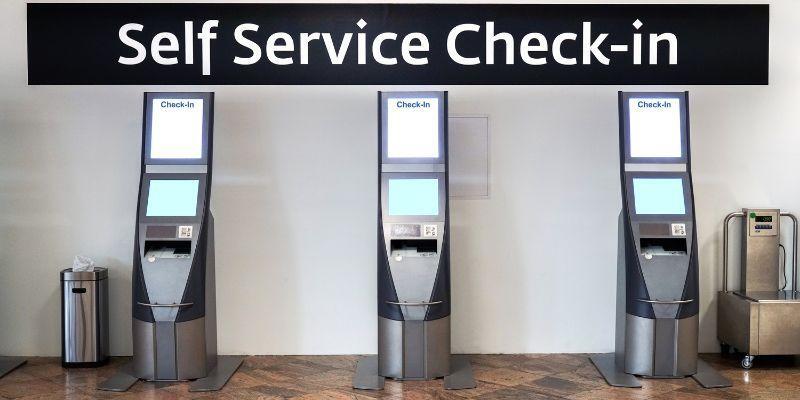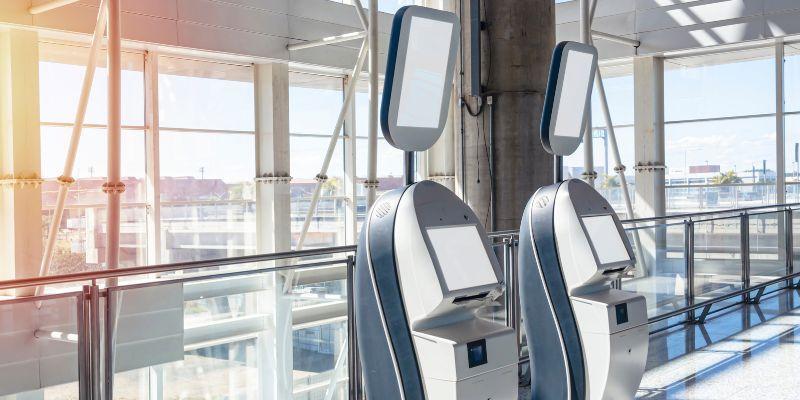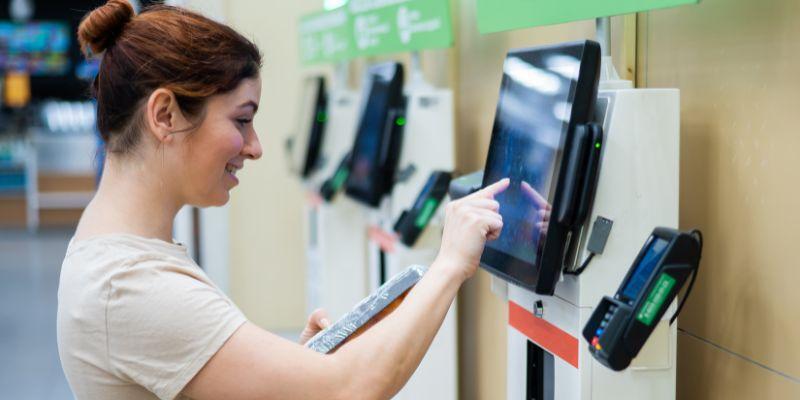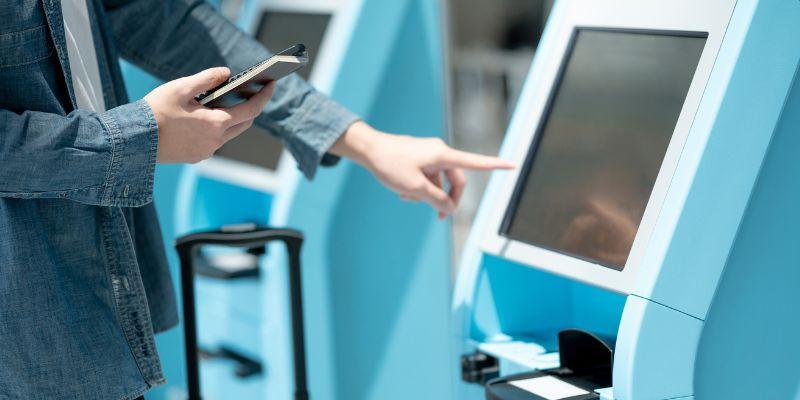Nowadays, self-service kiosks at airports are like personal travel assistants, making your journey smoother and quicker. These handy machines are strategically placed throughout airports, making travel more accessible.
Did you know that over 70% of travelers prefer using self-service kiosks for check-in and other tasks?
No more long lines or confusing check-in processes! With self-service kiosks, you can quickly get your boarding pass and stay updated on your flight status in real time. This means less waiting and more flexibility for you.
But it’s not just passengers who benefit. Airports also see improvements with self-service kiosks. They help reduce crowding and make everything run more smoothly. It’s a win-win situation for travelers and airports alike!
So, get ready to explore the world of self-service technology in airports. These kiosks are changing how we travel, one boarding passes at a time!
Definition of Airport Self Check-in Kiosk
An airport self-check-in kiosk is a user-friendly machine found in airports that allows travelers to handle various tasks independently. These kiosk machines are strategically located in high-traffic areas within the airport terminal.
With an airport kiosk, passengers can check in for their flights, print boarding passes, and even process luggage check-ins. These self-service kiosks aim to simplify the travel process, reducing wait times and increasing convenience for travelers.
By simply interacting with the touch-screen interface, passengers can complete essential tasks quickly and efficiently without needing assistance from airport staff.
How To Use Kiosk Machines at Airport

Kiosk machines at airports are designed to align your travel experience by offering a range of facilities and actions. These self-service terminals play a crucial role in modern air travel, providing convenient solutions for various tasks you may encounter before boarding your flight.
Check-In Process
Self-service kiosks at the airport make check-in easy. As passengers approach the self-service terminal, they effortlessly input their booking details or scan tickets.
The intuitive touch-screen interface guides them through selecting seats, printing boarding passes, and even tagging luggage.
With the integration of advanced features like people counting technology, queues are efficiently managed, ensuring a smooth and hassle-free check-in experience for all travelers.
From start to finish, airport kiosks streamline the check-in process, offering convenience and efficiency for passengers on their journey.
Baggage Drop-Off
Airport kiosks, specifically check-in kiosks at airports, facilitate a convenient baggage drop-off process for travelers. Once passengers have completed the check-in procedure at the kiosk, they can quickly proceed to the designated baggage drop-off area.
They tag their luggage and place it on the designated conveyor belt. Airport staff may assist with any queries or issues during this process. With the efficiency of airport check-in kiosks, passengers can quickly and securely drop off their baggage, saving time and ensuring a smoother process from check-in to boarding.
Boarding Pass and Seat Selection
Passengers can quickly obtain boarding passes and select their preferred seats using the airport’s self-service kiosk. After initiating the check-in process at the self-service kiosk airport, travelers can follow prompts on the user-friendly touch-screen interface.
They input their booking details or scan their boarding passes, then select seats from available options displayed on the screen. Once selections are made, the kiosk generates boarding passes for passengers to print.
With this convenient feature of the self-service kiosk airport, travelers have greater control over their journey, ensuring a comfortable and stress-free experience from check-in to boarding.
Additional Services
Self-service kiosks at airports enhance the airline customer experience by offering a range of convenient services beyond check-in. Travelers can print luggage tags, allowing for seamless tagging of checked baggage before proceeding to the drop-off point.
Moreover, passengers can change their flights directly at the kiosk, such as rebooking or upgrading seats. These self-service kiosks streamline the travel process, encouraging passengers to have control over their journey and contributing to a smoother and more personalized airline customer experience.
Features and Functionalities of Airport Kiosks
We will now examine the features and functions of airport kiosks and what they can achieve for passengers and improve the overall customer journey.
- Check-in Services: Print boarding passes, select seats, and bypass long queues.
- Baggage Tag Printing: Self-tag luggage and streamline the check-in process.
- Flight Information: Real-time updates on departure/arrival times, gate numbers, and delays.
- Boarding Pass Reprint: Quickly retrieve lost or forgotten passes.
- Seat Upgrades and Changes: Flexibility to upgrade or change seats pre-boarding.
- Airport Services Information: Locate amenities, restaurants, shops, and transportation options.
- Accessibility Features: Designed for inclusivity with adjustable height screens, tactile buttons, and audio instructions.
- Language Options: Multiple language support for international travelers.
- Customized Promotions and Offers: Exclusive deals from airlines, retailers, and airport businesses.
- Customer Service Assistance: Video chat or remote support for inquiries or issues.
Advantages of Self-Service Kiosks

Self-service kiosks at airports offer numerous advantages, revolutionizing passengers’ interactions with airport services. These automated terminals provide convenience, efficiency, and flexibility, enhancing the overall travel experience for travelers worldwide.
Let’s dive into the advantages of self-service kiosks and how they contribute to a hassle-free journey for passengers.
- Enhanced Passenger Experience
- Reduction In Queues and Wait Times
- Increased Operational Efficiency for Airlines and Airports
- Cost Savings and Revenue Generation Opportunities
1. Enhanced Passenger Experience
Self-service kiosks at airports significantly improve the passenger experience by providing convenience and efficiency. With these terminals, travelers can check in, print boarding passes, select seats, and even print luggage tags seamlessly.
By empowering passengers to manage their journey, self-service kiosks reduce wait times and streamline processes, leading to smoother transitions from check-in to boarding. Additionally, these kiosks offer flexibility, allowing passengers to change their flights and upgrades at their convenience.
2. Reduction in Queues and Wait Times
Airport kiosk check-in systems are pivotal in mitigating queues and reducing wait times for travelers. Utilizing a QMS (Queue Management System), these self-service kiosks efficiently handle the check-in process, minimizing congestion at traditional check-in counters.
Passengers can swiftly check in at the airport kiosk, eliminating the need to wait in long lines. This streamlined approach enhances the airport’s overall efficiency and ensures travelers a smoother and more expedited experience.
3. Increased Operational Efficiency for Airlines and Airports
Integrating self-service kiosks at airports enhances operational efficiency for airlines and airports. By leveraging business analytics, airlines can gain valuable insights into passenger behavior and preferences, optimizing resource allocation and service offerings.
Moreover, the streamlined processes facilitated by self-service kiosks reduce airline staffing needs and operational costs. Airports benefit from improved throughput and reduced congestion, leading to smoother operations and enhanced customer satisfaction.
Using airport kiosk machines allows passengers to independently manage their journey, freeing up staff to focus on more complex tasks.
4. Cost Savings and Revenue Generation Opportunities
Implementing self-service kiosks at airports presents significant cost-saving opportunities for airlines and creates avenues for revenue generation. Airlines can lower staffing costs and operational expenses by reducing the need for staffed check-in counters and streamlining processes.
Additionally, self-service kiosks allow airlines to upsell supplementary services, such as seat upgrades and baggage allowances, directly to passengers during check-in, thereby increasing revenue.
Furthermore, airports can capitalize on advertising and sponsorship opportunities through kiosk screens, generating additional revenue streams.
Implementations and Real-Life Cases
1. Advancing Airport Efficiency with Delta Airlines’ Self-Service Kiosks
Delta Airlines partnered with Wavetec to deploy self-service kiosks at airport lounges, developing passenger experience and operational efficiency.
These kiosks offer paperless ticketing, real-time queue updates, and seamless feedback mechanisms, reducing queuing times and increasing passenger satisfaction.
The deployment of self-service kiosks not only improves customer service, optimizes resource allocation, and reduces operational costs.
Through insightful analytics and reporting, airlines like Delta are poised to achieve higher ROI and industry-leading standards in customer service, steering in a new era of airport travel.
2. Enhancing Customer Service with Wavetec’s Kiosks at Emirates
Wavetec’s partnership with Emirates Airline revolutionized customer service across 71 global stations. By deploying an end-to-end solution including electronic queue management and central reporting software, Emirates enhanced efficiency and customer satisfaction,
Smart LCD touch-screen self-service kiosks enable streamlined customer categorization and priority calling, reducing wait times. The centralized reporting system facilitated real-time service quality and staff performance monitoring, empowering Emirates to optimize resources.
With tailored solutions and branded self-service kiosks reflecting Emirates’ corporate identity, Wavetec provided a near-perfect customer experience.
Future Outlook and Trends

The future of airport self-service kiosks holds exciting possibilities as technological advancements continue to shape the travel experience.
From biometric authentication to artificial intelligence-driven personalization, the evolution of airport kiosks promises to revolutionize passenger interactions and modernize airport operations.
Let’s look at the future o and emerging trends that redefine the role of self-service kiosks in the aviation industry.
- Innovations In Self-Service Kiosk Technology
- Integration With Biometrics and Facial Recognition
- Expansion Into Additional Airport Services
- Potential Challenges and Opportunities in A Post-Pandemic Travel Landscape
1. Innovations in Self-Service Kiosk Technology
Advancements in self-service kiosk technology at airports are transforming the travel experience. With user-friendly interfaces and intuitive functionalities, passengers can effortlessly check in, print boarding passes, and even select seats at the airport kiosk. These innovations streamline processes, reducing wait times and enhancing overall efficiency.
2. Integration with Biometrics and Facial Recognition
Integrating biometrics and facial recognition technology into airport kiosks revolutionizes identity verification processes. Kiosks scan passengers’ biometric data, such as fingerprints or facial features, to ensure secure and efficient check-ins.
3. Expansion into Additional Airport Services
Airport kiosks are expanding beyond check-in functionalities to offer a broader range of services. Passengers can now utilize kiosks to print luggage tags, update flight information, and purchase additional services like lounge access or in-flight amenities. This expansion enhances the convenience and flexibility of self-service options at airports.
4. Potential Challenges and Opportunities in A Post-Pandemic Travel Landscape
The post-pandemic travel landscape presents both challenges and opportunities for airport kiosks. While hygiene and social distancing concerns may impact passenger interactions with kiosks, advancements in contactless technology offer solutions to address these concerns.
The shift towards digitalization and self-service options also presents opportunities for further innovation and customization in airport services, ensuring passengers’ safe and uniform travel experience.
Final Words
In conclusion, self-service kiosks at airports have transformed how passengers interact with airport services, providing convenience, efficiency, and flexibility.
These automated terminals streamline processes such as check-in, printing boarding passes, and selecting seats, significantly reducing wait times and improving overall travel experiences.
Imagine an airport where advanced technology like biometrics and facial recognition makes check-in secure and quick. Plus, self-service kiosks do more than ever, from printing luggage tags to giving you flight updates, making your trip easier.
Even with today’s travel challenges, technology keeps pushing us forward. Self-service kiosks lead the way, giving you control over your journey and making airports more enjoyable for everyone.
Overall, self-service kiosks play a central role in shaping the future of air travel. They offer passengers more control over their journey and contribute to a more aligned and enjoyable airport experience.
BOOK A FREE DEMO





